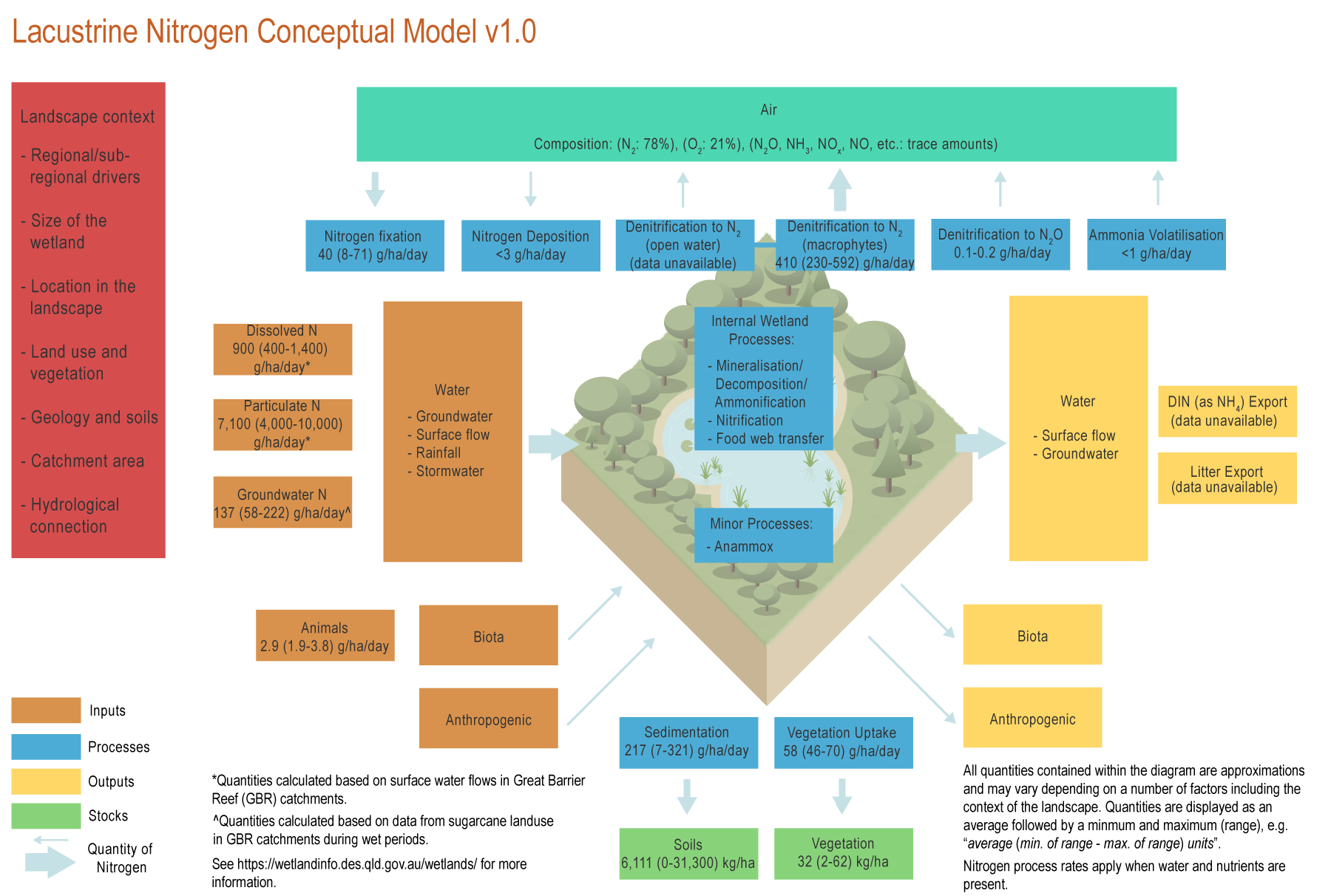|
|
LacustrineLacustrine – Processes
The conceptual models were compiled by researchers in collaboration with a wide range of stakeholders from Natural Resource Management groups, universities and government agencies and based on available scientific information[2]. Click on elements of the model or select from the tabs below Lacustrine wetlands (lakes) have the largest water to soil ratio of all the wetlands and are dominated by aquatic transformations of nitrogen in aerobic conditions, e.g. in surface waters. Ammonia volatilisationAmmonia volatilisation occurs in basic conditions (higher than pH 8) and where concentrations of urea (derived from animals) are relatively high[15]. AnammoxAnammox (anaerobic ammonia oxidation) is likely to be a minor process in lakes[9][16]. Biomass accumulation (vegetation)Nitrogen in lakes can be accumulated as macrophytes. These macrophytes may uptake approximately 58 (46-70) g of N per day[1], but most of this nitrogen will return to the soil/sediment when the plants die[11] or are consumed by animals. Areas of excessive weed growth may be an indication of high nitrogen accumulation[12]. Mineralisation (Decomposition/Ammonification)In the littoral zone, where macrophytes can be abundant, decomposition can be high during periods of low water levels[11]. After dying, the macrophytes (including invasive weeds) will release N, which they have stored in their tissue[11]. In open water, algal or macrophyte blooms can produce high volumes of organic matter that can be deposited in the bottom of the lake, where some of it can be decomposed and some stored (i.e. recalcitrant matter not broken down). Ammonification proceeds slowly in anaerobic environments, but it can be high in tropical lakes due to high temperatures that allow fast nutrient cycling[10]. DenitrificationDenitrification in lakes is likely to be highest in areas of the lake with abundant macrophytes[2] (410 (230-592) g/ha/day), and in lake sediments, where carbon is abundant, and where nitrate is available. Lower rates of denitrification typically occur in areas of open water[16]. Denitrification can also occur under floating macrophyte beds (including weed mats), however, if the weed mats are too dense the conditions can become too anoxic for denitrification to occur[4]. Food chain transferLacustrine wetlands are likely to have high N transfers through the food chain (food web), especially in sites where epiphyton or phytoplankton are abundant[8]. Epiphyton are most abundant where macrophytes with complex structures occur in shallow areas of lakes[14]. Lakes connected to coastal waterways, are hotspots for N consumption by resident or migratory animals[8], especially where diatoms, an important source of nutrition for animals, are abundant. NitrificationNitrification is likely to occur in areas around the edge of the lake where macrophytes are abundant, but not where they are so dense that conditions are anoxic[13][16][2]. Nitrogen deposition from the atmosphereNitrogen can be deposited from the atmosphere to the biosphere as gas, dry deposition and aerosol particles entrained in rain or other precipitation. However, N deposition is only significant in areas with high industrial activity[15]. In the Great Barrier Reef catchments, N deposition is likely to be less than 3 g/ha/day[15]. Nitrogen fixation from the atmosphereIn surface waters, nitrogen (N) fixation can be significant (40 (8-71) g/ha/day)*. The fixation process can be enhanced:
SedimentationLakes can receive sporadic, but large amounts of sediment with associated particulate N, especially during large floods. Nitrogen accumulated in the sediment (217 (7-321) g/ha/day)* will be higher in areas with large suspended sediment loads and long residence times[5]. At the central, deeper area of lakes, sediment can accumulate in large quantities, typically at rates of 1-2 mm/yr[3][6]. Excess sediment can fill up lakes leading to the loss of the lake and associated values and services. *Nitrogen quantities are displayed as an average followed by a minimum and maximum (range), e.g. “average (min. of range - max. of range) units”. References
Last updated: 2 August 2021 This page should be cited as: Department of Environment, Science and Innovation, Queensland (2021) Lacustrine – Processes, WetlandInfo website, accessed 8 May 2025. Available at: https://wetlandinfo.des.qld.gov.au/wetlands/ecology/processes-systems/nitrogen-concept-model/lacustrine/processes.html |

 — Department of the Environment, Tourism, Science and Innovation
— Department of the Environment, Tourism, Science and Innovation

